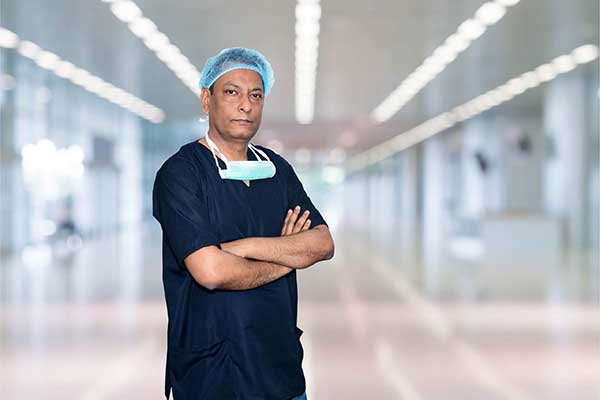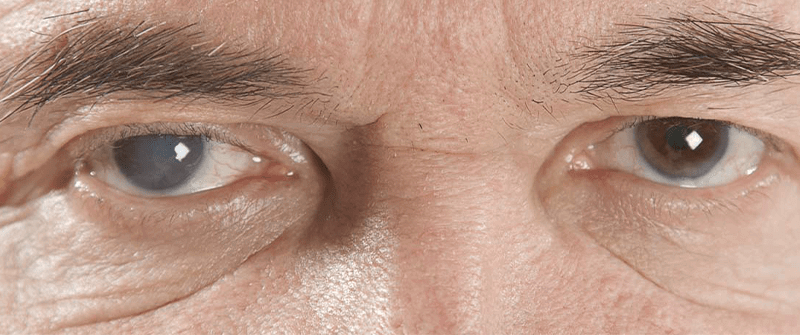Best Cataract Surgeon in Delhi
About Dr. Surya Kant Jha - Ophthalmologist/ Eye Surgeon
(MS - Ophthalmology, MBBS, 21 Years Experience Overall (13 years as Specialist)
Dr. Surya Kant Jha is a renowned cataract Surgeon in Delhi, known for his exceptional expertise in advanced cataract and refractive surgeries. Practicing ophthalmology since 2010, he has established himself as one of the most trusted eye specialists in Delhi and the NCR region. Over the years, Dr. Surya Kant Jha has served as a Senior Consultant at several top-tier eye hospitals, including Fortis Hospital (Vasant Kunj), Center for Sight (Delhi & Jaipur), ASG Eye Hospital (Jaipur), and Venu Eye Institute, New Delhi—working closely with some of India's leading cataract surgeons.
With more than 10,000+ cataract surgeries and 5,000+ phacoemulsification procedures to his name, Dr. Surya Kant Jha is widely recognized for delivering safe, precise, and successful cataract outcomes. His expertise covers the entire spectrum of cataract care, from early diagnosis to premium IOL-based cataract surgery and laser-assisted cataract procedures. His primary areas of interest include Cataract Surgery, Micro-incision Cataract Surgery (MICS), Femto Laser Cataract Surgery, and Refractive Correction.

What is Cataract Surgery?
A cataract is a common eye condition in which the eye’s natural lens becomes cloudy. Normally, this lens is clear and helps focus light for sharp vision. When a cataract develops, the lens loses its transparency, leading to blurred vision, difficulty seeing at night, and faded or dull colors.
It’s similar to looking through a foggy or dirty window—objects are visible but not clear.
Cataracts usually develop gradually with age but may also occur due to diabetes, eye injury, prolonged use of certain medications, or genetic factors. Cataracts are not contagious and do not spread from one eye to the other.
The good news is that cataracts can be treated safely and effectively through a quick and simple cataract surgery. During the procedure, the cloudy lens is removed and replaced with a clear artificial intraocular lens (IOL), helping restore bright, sharp, and clear vision.
Causes of Cataract
- Smoking
- Ultraviolet Radiation
- Long-term Use of Steroids
- Diabetes
- Radiation Therapy
- Trauma
- Overproduction of Oxidants

Symptoms Indicating the Need for Cataract Surgery
If you experience any of the following symptoms, it may be time to consult Dr. Suryakant Jha, one of the best cataract surgeons in Delhi:
- Blurred or cloudy vision.
- Increased difficulty seeing in dim light or at night.
- Sensitivity to bright lights and glare.
- Fading or yellowing of colors.
- Double vision in one eye.
- Frequent changes in eyeglass or contact lens prescription.
Cataracts develop gradually, and early diagnosis can help prevent significant vision loss. Regular eye check-ups can detect cataracts in their early stages, allowing timely intervention.
Different Types of Cataracts
Cataract surgery has evolved with various techniques to restore clear vision. Several types of cataracts are available, each with its unique approach:
- Nuclear Cataracts: It forms the middle of the lens and causes the nucleus to turn yellow.
- Cortical Cataracts: They are wedge-shaped and formed around the edge of the nucleus.
- Traumatic Cataracts: Generally, they develop after an injury to the eye.
- Congenital Cataracts: The type of cataract formed during birth or forms during the baby’s birth.
- Posterior Capsular Cataracts: This type of cataract forms very fast and affects the back of the lens.
- Secondary Cataracts: An overdose of steroid prednisone and other medications can sometimes lead to this type of cataract.
- Radiation Cataracts: They form after a person undergoes radiation treatment for cancer.
Cataract Surgery Procedure:
Cataract surgery is a simple and safe outpatient procedure that typically takes 15-20 minutes per eye. Here’s a step-by-step overview of what to expect:
Pre-Surgery Preparation
- A thorough eye examination is conducted to assess the cataract and determine the best surgical approach.
- Eye measurements are taken to select the appropriate intraocular lens (IOL).
- Patients are advised on medications and dietary restrictions before the surgery.
During Surgery
- Local anesthesia (eye drops or injections) is administered to numb the eye.
- A small incision is made to remove the clouded lens.
- An artificial intraocular lens (IOL) is implanted to replace the natural lens.
- The incision is self-sealing, requiring no stitches.
Post-Surgery Recovery
- Patients can return home the same day.
- Mild discomfort, redness, and blurred vision may occur initially but subside within a few days.
- Regular follow-ups ensure proper healing and monitor vision improvement.
In case, you feel uncomfortable, the ophthalmologist will talk with you about the procedure of cataract surgery with the available techniques.
Types of Cataract Surgery:
Cataract surgery is a common and highly effective procedure to restore vision in individuals with cataracts. In Delhi, there are several advanced techniques for cataract removal, ensuring minimal discomfort and quick recovery. Here are the main types of cataract surgeries available:
1. Phacoemulsification (Phaco Surgery)
- The most common and advanced cataract surgery.
- A tiny incision is made, and an ultrasound probe is used to break the cloudy lens into small fragments, which are then removed.
- A foldable intraocular lens (IOL) is implanted.
- Quick recovery with minimal stitches.
2. Micro-Incision Cataract Surgery (MICS)
- An advanced form of Phaco surgery with an even smaller incision (less than 2mm).
- Reduces surgical trauma and speeds up recovery.
- Provides better post-surgical vision clarity.
3. Femtosecond Laser-Assisted Cataract Surgery (FLACS)
- A bladeless, laser-assisted surgery for precise incision-making and lens fragmentation.
- Enhances accuracy, reduces surgical time, and improves safety.
- Ideal for patients with astigmatism as it can correct corneal imperfections.
4. Extracapsular Cataract Extraction (ECCE)
- Used for advanced cataracts that are too hard for phacoemulsification.
- A larger incision is made to remove the cloudy lens in one piece.
- Requires sutures and has a longer recovery time.
5. Intracapsular Cataract Extraction (ICCE)
- An older technique where both the lens and the capsule are removed.
- Rarely performed today due to a higher risk of complications.
- Used in cases of severe eye trauma or other special conditions.
6. Refractive Cataract Surgery
- A customized surgery that corrects vision problems like presbyopia or astigmatism along with cataract removal.
- Premium intraocular lenses (Multifocal, Toric, and EDOF IOLs) are used for better vision without glasses.
Risk Factors Associated With Cataract
- People Aged 60 Years and Above
- High Blood Pressure
- Any Previous Eye Injury
- Excessive Sun Exposure
- History of Steroid Use
What are the Latest Surgical Techniques for Cataract Surgery?
The latest surgical techniques for cataract surgery incorporate advanced technologies to improve precision, safety, and recovery time. Here are some of the most cutting-edge procedures:
Microincision or Regular Phaco Cataract Surgery
In traditional microincision and phacoemulsification cataract surgery, capsulotomy is done manually by using a bent needle. This opening allows the ultrasound waves to coalesce the natural lens of the eye before it is taken out of the eye with the help of a vacuum. When it is manually performed, this capsulotomy tends to go to one side, resulting in the capsular bag tear. This implies that the Intraocular lens that gets implanted might not be as stable as it needs to be.
Robotic or Femtosecond Cataract Surgery
To eliminate the error caused by microincision surgery, this Femtosecond laser cataract surgery was developed. It makes use of a laser beam for creating the capsulotomy and further reduces the likelihood of human error and any other complications. Though it requires a little more time, you will get an excellent visual. It is at 100 pct. This surgery is known for being painless and stitchless. This surgery cannot be done on patients with small pupils.
ZeptoCapsulotomy Cataract Surgery
This type of surgery is cheaper than femtosecond cataract surgery and uses a handheld disposable apparatus to create a strong capsulotomy. It also results in fewer logistical challenges and costs and less surgical time. We provide this surgery more safely.
Approval
US FDA has approved Cataract Surgery. It is considered to be the safest procedure for spec removal.
Cataract Surgery Cost in Delhi
One of the most common concerns among patients is the cataract surgery cost in Delhi. The cost of cataract surgery in Delhi varies depending on several factors, including the type of surgery, the choice of intraocular lens (IOL), the technology used, and the surgeon’s expertise. You can ask your ophthalmologist to give you an estimate of the surgery based on the procedure you choose.
Estimated Cataract Surgery Cost in Delhi: ₹20,000 to ₹1,25,000 per eye
Factors Affecting Cataract Surgery Cost in Delhi:
- Type of Intraocular Lens (IOL): Premium lenses such as multifocal or toric lenses are costlier than standard monofocal lenses.
- Technology Used: Laser-assisted procedures tend to be more expensive than traditional methods.
- Surgeon’s Experience: Highly experienced surgeons may charge more for their expertise and success rates.
- Hospital Facilities: State-of-the-art hospitals with advanced equipment may have higher charges for better care and amenities.
Despite the cost variations, investing in the best cataract surgery in Delhi ensures better long-term results and a higher quality of life.
Best Cataract Surgeon in Delhi | Dr. Surya Kant Jha
Dr. Surya Kant Jha is the best surgeon for Cataract Surgery. When you want to get Cataract Surgery in Delhi done, then it is really important to choose a good cataract surgeon for your surgery. At EVA Dr. Suryakant Jha is the best cataract surgeon in Delhi with the latest infrastructure and technology. We give most beneficial results after cataract surgery by our top surgeon.
Why Choose Dr. Surya Kant Jha For Cataract Surgery?
Dr. Suryakant Jha is a highly experienced and skilled cataract surgeon in Delhi with a strong reputation for performing safe and successful cataract surgeries in Delhi. His expertise, combined with state-of-the-art equipment at Eterna Vision & Aesthetics, ensures that patients receive world-class treatment with minimal discomfort and excellent outcomes.
- Extensive experience in performing cataract surgeries with precision.
- Expertise in the latest laser-assisted and phacoemulsification techniques.
- Use of premium intraocular lenses (IOLs) for optimal vision correction.
- Personalized treatment plans tailored to individual patient needs.
- Compassionate and patient-centric approach to eye care.
- Advanced diagnostic and surgical equipment at Eterna Vision & Aesthetics.
If you have been diagnosed with cataracts or are concerned about cataracts, there is no need to worry. At Eterna Vision & Aesthetics, the best eye hospital for cataract surgery in Delhi, Dr. Surya Kant Jha is one of the best cataract surgeons in India, ready to provide expert consultation for all your eye-related concerns.
Patient Feedback
FAQ
Yes, surgery is the only effective treatment for cataracts. As they progress, they can significantly impact your vision, and surgery is the best way to address this.
There is no medication for cataracts. However, different surgical procedures are available for treating cataract. The surgical procedures that could be chosen are Extracapsular cataract extraction and Intracapsular cataract extraction.
There won’t be any visible scarring but there might be a small redness in the eye. After the surgery, you will be able to go home by wearing an eye pad and shield. The shield must be worn for the first week at night. Your vision will start to improve after the second day. However, you might experience a slight blurring or misting in the eyes, which would improve with time.
The moment you face difficulty with your vision, you can talk with your ophthalmologist.
A cataract starts to develop from the age of 40 and it intensifies when one attains the age of 50 and 60.
Research the qualifications and experience of the surgeon, read patient reviews, and consider the clinic's reputation for quality care and safety.


